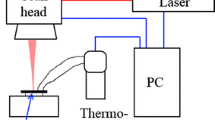Abstract
This paper investigates the effects of process parameters (laser power, scan speed, frequency and fill spacing) on the laser deep engraving of AISI 316 stainless steel. The optimum process conditions for minimization of the surface roughness and maximization of the engraving depth are also determined. An experimental investigation consisting of 108 different combinations is carried out to determine the process parameters which contribute engraved surface roughness and depth. The results indicate that both surface roughness and engraving depth significantly decrease with an increase in the scan speed and a decrease in the laser power. A second order regression model is also used to formulate the relationship between the parameters and process responses. The results of the regression analysis show that the calculated values from the regression model and measured values from the experiments are very similar. Moreover, the results suggest that the regression model might be used to predict the surface roughness and engraving depth.

Similar content being viewed by others
References
Gillner A., Holtkamp J., Hartmann C., Olowinsky A., Gedicke J., Klages K., Bosse L., Bayer A: Laser applications in microtechnology. J. Mater. Process. Technol. 167, 494–498 (2005)
Yasa E., Kruth J.P: Investigation of laser and parameters for selective laser erosion. Precision Eng. 34, 101–112 (2010)
Wendland, J.P.; Harrison,M.; Henry, M.; Brownell, M.: Deep engraving of metals for the automotive sector using high average power diyod pumped solid state lasers. In: International congress on application of lasers and electro-optics, Miami, October (2005)
Campanelli S.L., Ludovico A.D., Bonserio C., Cavalluzzi P., Cinquepalmi M: Experimental analysis of the laser milling process parameters. J. Mater. Process. Technol. 191, 220–223 (2007)
Pham D.T., Dimov S.S., Petkov P.V: Laser milling of ceramic components. Int. J. Mach. Tools Manuf. 47, 618–626 (2007)
Pham, D.T.; Dimov, S.S. Petkov, P.V.; Dobrev, T.: Laser milling for micro tooling. Laser metrology and machine performance. In: VIII Lamdamap Conference Proceedings, pp. 362–371 (2005)
Leone C., Lopresto V., De Iorio I: Wood engraving by Q-switched diode-pumped frequency-doubled Nd:YAG green laser. Optics Lasers Eng. 47, 161–168 (2009)
Chen Y.H., Tam S.C., Chen W.L., Zheng H.Y: Application of Taguchi method in the optimization of laser micro-engraving of photomasks. Int. J. Mater. Prod. Technol. 11, 333–344 (1996)
Lee J.H., Jang J.H., Joo B.D., Son Y.M., Moon Y.H: Laser surface hardening of AISI H13 tool steel. Trans. Nonferrous Metals Soc China. 19, 917–920 (2009)
Beal, V.E.; Erasenthiran, P.; Hopkinson, N.; Dickens, P.; Ahrens, C.H.: Optimization of processing parameters in laser fused H13/Cu materials using response surface method (RSM). J. Mater. Process. Technol. 174, 145–154 (2006)
Stavrev, D.S.; Dikova, TS.D.; Shtarbakov,Vl.; Milkov, M.P.: Laser surface melting of austenitic Cr–Ni stainless steel. In: The International Conference on Advances in Materials and Processing Technologies (Ampt 2009), Malaysia (2009)
Montgomery, D.C.: Design and Analysis of Experiments. Wiley, New Jersey (2001)
Palanikumar K., Muthukrishnan N., Hariprasad K.S: Surface roughness parameters optimization in machining A356/SiC/20p metal matrix composites by PCD tool using response surface methodology and desirability function. Mach. Sci. Technol. 12, 529–545 (2008)
Palanikumar K: Modeling and analysis for surface roughness in machining glass fibre reinforced plastics using response surface methodology. Mater. Design. 28, 2611–2618 (2007)
Kansal, H.K.; Singh, S.; Kumar, P.: Parametric optimization of powder mixed electrical discharge machining by response surface methodology. J. Mater. Process. Technol. 169, 427–436 (2005)
Author information
Authors and Affiliations
Corresponding author
Rights and permissions
About this article
Cite this article
Kasman, Ş., Saklakoğlu, İ.E. Experimental Investigation and Mathematical Modeling of Laser Deep Engraving Process for Microapplication. Arab J Sci Eng 38, 1539–1549 (2013). https://doi.org/10.1007/s13369-013-0561-x
Received:
Accepted:
Published:
Issue Date:
DOI: https://doi.org/10.1007/s13369-013-0561-x




